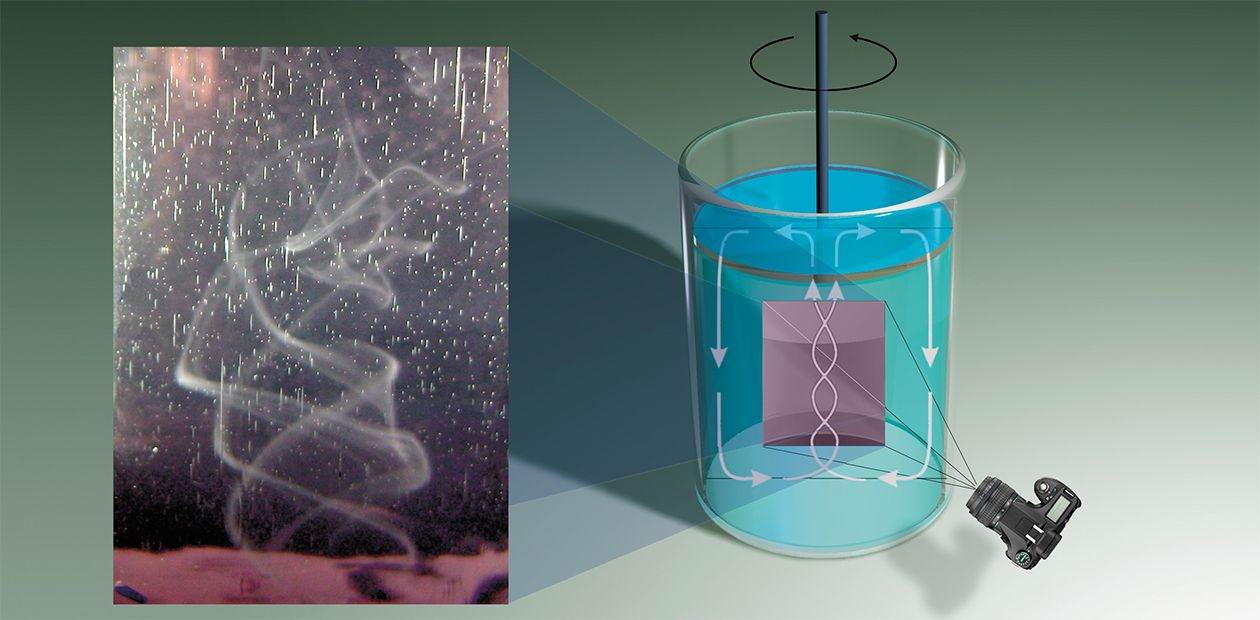Multiheical Vortices
A team of researchers from the Kutateladze Institute of Thermophysics of the Siberian Branch of the Russian Academy of Sciences and from the Technical University of Denmark demonstrated and experimentally studied stable configurations of self-organizing vortex multiplets in a swirled fluid flow generated in the cavity of a cylinder by its rotating lid
The behavior of equilibrium coherent configurations of several vortices (vortex multiplets) has been in the focus of basic and applied research since the 19th century. Today the issue of the structure of such configurations is of principal importance both for the development of the vortex concept of the turbulence theory and for the analysis of complicated processes in intensely swirled flows encountered in nature and in various engineering applications.
The theory of point vortices predicts that up to seven vortices can exist in equilibrium circular configurations; its extension to helical vortices decreases this prediction to six vortices.
In reality, however, it is extremely difficult to determine the spatial structures of rotating vortex multiplets: until recently, experimental data were only available on the structure of duplets (double-helical or double vortices). More complicated multiplets could not be visualized. An exception was tracing of tip vortices shed from the blades of a rotating turbine or a propeller.
Vortex multiplets are formed after the breakdown of a single vortex. Therefore, an experimental study of this process is important not only for understanding the nature of this phenomenon, but also for investigating various vortex configurations. It is in this manner that vortex duplets were studied previously.
The breakdown of a vortex formed in a fluid can be visualized in a laboratory experiment by using a coloring agent (dye). The breakdown of a concentrated vortex is characterized by drastic deceleration of its axial velocity, sometimes resulting in formation of a reverse flow (recirculation) region. This process can be traced by looking on the dye captured by the vortex, the dye being initially distributed strictly along the vortex axis.
The collaborative work of the Siberian and Danish researchers included a series of experiments aimed at identifying the spatial structure of stable multiplet forms of vortex breakdown. The experiments were performed in two similar experimental facilities: circular cylinders with a rotating lid, which differed only in the cylinder size and fluid type. The characteristics of the swirled flow generated in these cylinders by rotating lid were determined by two regime parameters: the ratio of the cylinder height to the base radius and the Reynolds number related to the angular velocity of lid rotation and to fluid viscosity. The experiments were performed in cylinders with diameters of 5.6 and 30 cm containing distilled water and 75 % water-glycerin mixture, respectively.
A direct comparison of the visualized flow patterns obtained in both facilities shows that identical regime parameters cause identical regimes of vortex breakdown with stable reproduction of vortex multiplets. The fact that the visualization patterns are not accidental is confirmed by studying the three-dimensional velocity field constructed with the help of a digital stereoscopic system for three-dimensional particle image velocimetry in regimes where stable vortex structures were formed. This studymade it possible not only to determine the beginning of transition from an axisymmetric flow to a flow with equilibrium rotating multiplets, but also to identify the arising vortex structure.
From the application viewpoint , the existence of such phenomenon as vortex breakdown with formation of vortex multiplets is extremely important. It can become a starting point for describing particular regimes of operation of vortex facilities, for developing a concept of multicellular cloud formation, and also for modeling tornados with a multivortex structure of the core flow.
References
Naumov I. V., Okulov V. L., and Sorensen J. N. Application of 3D PIV for diagnosing self-organizing vortex multiplets // Optical Methods of Flow Study, Proc. 10th International Conf., Moscow, June 23—26, 2009. Moscow Energy Institute. Moscow, 2009. P. 342—345.
Okulov V. L. On the stability of multiple helical vortices // J. Fluid Mech., 2004. V. 521. P. 319—342.
Okulov V. L., Naumov I. V., and Sorensen J.N. Self-organizing vortex multiplets in a swirled flow // Pisma v Zh. Tekh. Fiz., 2008. V. 34. No. 15. P. 89—95.





